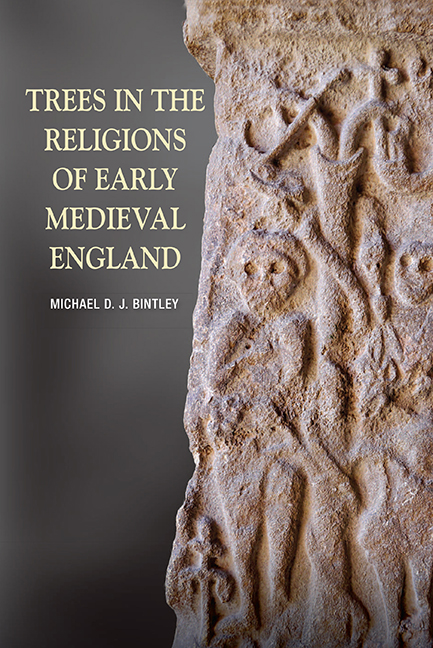Book contents
- Frontmatter
- Contents
- List of Illustrations
- Acknowledgements
- Introduction
- 1 Holy Trees and Inculturation in the Conversion Period
- 2 Anglo-Saxon Holy Trees and their Northern European Counterparts
- 3 Rewriting the Holy Rood in Anglo-Saxon Spiritual History
- 4. The Human Forest: People and Trees in Early Medieval England and Scandinavia
- Summary
- Bibliography
- Index
- Anglo-Saxon Studies
3 - Rewriting the Holy Rood in Anglo-Saxon Spiritual History
Published online by Cambridge University Press: 11 June 2021
- Frontmatter
- Contents
- List of Illustrations
- Acknowledgements
- Introduction
- 1 Holy Trees and Inculturation in the Conversion Period
- 2 Anglo-Saxon Holy Trees and their Northern European Counterparts
- 3 Rewriting the Holy Rood in Anglo-Saxon Spiritual History
- 4. The Human Forest: People and Trees in Early Medieval England and Scandinavia
- Summary
- Bibliography
- Index
- Anglo-Saxon Studies
Summary
The first half of this book has argued that Christian missionaries made use of the symbolic role of trees in the Anglo-Saxon pre-Christian tradition, effecting an inculturative process of conversion in which trees served as one of many conventional bridges between the two belief systems. This chapter is about how trees became a normalised part of early English Christianity, and how the Anglo-Saxons recast the role of trees in their pre-Christian history, bringing them in line with the Judaeo-Christian tradition. It begins by examining episodes in Bede's Historia Ecclesiastica (a number of which are connected with St Oswald) in which sacred trees, posts, pillars and other wooden objects achieved Christian cult status. Many of these were still venerated in Bede's day. Having already considered the Ruthwell and Bewcastle crosses in Chapter 1, I consider a panel from one of the ninth-century crosses that stand in the marketplace at Sandbach, in Cheshire. The decoration of this monument may suggest that the Anglo-Saxons were being encouraged to re-evaluate the role of trees in their ancestral traditions, seeing them in the same light as those sacred trees, staffs and pillars in the Judaeo-Christian scriptural tradition that had prefigured the cross of Christ. The sculptural decoration of the southern cross may share certain ideas in common with the thematic programme of the poetic codex Junius 11, the only one of the poetic codices to have been executed with a full programme of illustration in mind. Although Junius 11 is incomplete in its surviving form, the four poems that make up this manuscript (Genesis, Exodus, Daniel, Christ and Satan) have been seen as an effort to chart the course of human spiritual history with reference to the traditions of those for, and by whom, it was created. Trees, posts and pillars are prominent in each of the four poems, as well as the manuscript's unfinished cycle of illustrations. Consequently, this codex can be seen as part of an attempt to recast the role of trees in their ancestor's world view in the same light as similar objects in the Judaeo-Christian tradition – as prefigurations of the cross and their own conversion. The chapter concludes with a discussion of Bede's Latin poem De Die Iudicii, and the changes it underwent when it was translated into the Old English Judgement Day II some two centuries after his death.
- Type
- Chapter
- Information
- Trees in the Religions of Early Medieval England , pp. 91 - 128Publisher: Boydell & BrewerPrint publication year: 2015



